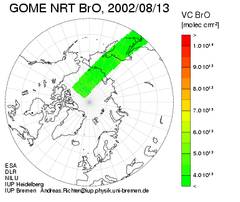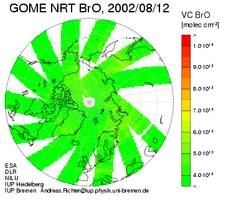GOME NRT Bromine Monoxide
Please note that these maps are small versions and that each map is clickable. A new window will appear with the normalsized jpg-version of the map. You should use a browser with activated JavaScript. Otherwise go to the Archive section down below, where a data page for each day is available. A brief introduction can also be found further down below.
NOTE: The ERS-2 platform is operating in gyroless mode since February 2001. Attitude and pointing control is now achieved using digital earth sensors and payload data. Several refinements of the software have been improving the ERS2 performance. Nevertheless, passive tracking of the sun on a daily basis is not always possible. Extended periods of no direct solar measurements in combination with several cooler switching can lead to artificial spectral structures in the sun-normalised eartshine nadir radiances impacting the trace gas retrieval. The quality of all trace gas data products presented here may be reduced. For most recent news on ERS2 performance contact ESA/ESRIN web pages.
All results on this page are preliminary!


Archive
December 2001 January 2002 February 2002
Mo Tu We Th Fr Sa Su Mo Tu We Th Fr Sa Su Mo Tu We Th Fr Sa Su
1 2 1 2 3 4 5 6 1 2 3
3 4 5 6 7 8 9 7 8 9 10 11 12 13 4 5 6 7 8 9 10
10 11 12 13 14 15 16 14 15 16 17 18 19 20 11 12 13 14 15 16 17
17 18 19 20 21 22 23 21 22 23 24 25 26 27 18 19 20 21 22 23 24
24 25 26 27 28 29 30 28 29 30 31 25 26 27 28
31
March 2002 April 2002 May 2002
Mo Tu We Th Fr Sa Su Mo Tu We Th Fr Sa Su Mo Tu We Th Fr Sa Su
1 2 3 1 2 3 4 5 6 7 1 2 3 4 5
4 5 6 7 8 9 10 8 9 10 11 12 13 14 6 7 8 9 10 11 12
11 12 13 14 15 16 17 15 16 17 18 19 20 21 13 14 15 16 17 18 19
18 19 20 21 22 23 24 22 23 24 25 26 27 28 20 21 22 23 24 25 26
25 26 27 28 29 30 31 29 30 27 28 29 30 31
|
Introduction
GOME BrO maps are created at the University of Bremen by applying the DOAS (Differential Optical Absorption) algorithm to GOME lv1 near real time spectra received from the Kiruna ground station.
In the DOAS retrieval, atmospheric absorbers are identified by their characteristic spectral absorption signature. In order to separate molecular absorptions from broad band scattering features, only the differential part of the absorption is used. In the case of BrO, the absorption bands in the 345 to 359 nm region are used for the detection. As GOME is essentially a nadir viewing instrument, the result of the DOAS analysis is the absorber column integrated along the line of sight. To convert this into a vertical column, the light path through the atmosphere is modelled using radiative transfer calculations, and a correction factor (airmass factor or AMF) is applied to the measurements. This airmass factor depends on the assumed vertical profile of the absorber, in particular in the UV.
All BrO plots on this page are derived using a standard airmass factor appropriate for a high latitude stratospheric BrO profile. This implies, that tropospheric BrO events in the Arctic are underestimated, in particular early in the year. The BrO columns in these regions are therefore to be interpreted in a qualitative way only. A separation between troposphere and stratosphere is not feasible for a near real time product but will be subject of a more detailed study.
Regions with enhanced tropospheric BrO are identified by their large vertical columns. However, it is important to note that stratospheric BrO columns do also vary, by subsidence in the polar vortex, but also with changes in tropopause height. Part of the high values observed in the Arctic are correlated to high pressure systems and not indicative of tropospheric BrO.
When analysing GOME BrO maps, one has also to keep in mind that clouds block the satellites view of absorbers in the boundary layer. In addition, in the wavelength region used for the BrO retrieval the contribution of tropospheric signals to the total radiance is small with the exception of scenarios with snow or ice on the ground. The absence of large BrO signals over open water therefore does not necessarily imply the absence of BrO over these regions.
More detailed information on the GOME BrO analysis at the University of Bremen can be found in the following publications:
- A. Richter, F. Wittrock, M. Eisinger, and J.P.Burrows, GOME observations of tropospheric BrO in Northern Hemispheric spring and summer 1997, Geophys. Res. Lett., 25, 2683-2686, 1998 (PDF-File).
- A. Richter, F. Wittrock, and J.P.Burrows, GOME observations of tropospheric BrO, in Proceedings of the European Symposium on Atmospheric Measurements from Space, 1999 (zipped PS-File).
- F. Wittrock, A. Richter, and J.P.Burrows, Validation of GOME BrO and OClO observations in the Northern Hemisphere, in Proceedings of the European Symposium on Atmospheric Measurements from Space, 1999 (zipped PS-File).
- Richter, A., Kreher, K., Johnston, P. V., Wittrock, F., and J. P. Burrows, Validation of GOME O3, NO2, BrO, and OClO Measurements in Southern High Latitudes, Fifth European Workshop on Stratospheric Ozone, 1999 (zipped PS-File).
- Richter, A., F., Wittrock, A. Ladstätter-Weissenmayer, and J.P. Burrows, GOME measurements of stratospheric and tropospheric BrO, submitted to Adv. Space Res., 2000 (PDF-File).
More on BrO from GOME can be found in the following publications:
- T. Wagner and U. Platt, Satellite mapping of enhanced BrO concentrations in the troposphere, Nature, 395, 486-490,1998
- E. Hegels, P.J. Crutzen, T. Klüpfel, D. Perner, and J.P. Burrows, Global distribution of atmospheric bromine oxide from GOME on the earth observing satellite ERS-2, Geophys. Res. Lett., 25, 3127-3139, 1998
- K. Chance, Analysis of BrO measurements from the Global Ozone Monitoring Experiment, Geophys. Res. Lett., 25, 3335-3338, 1998
Last change: 12/14/2001
Contact: Andreas Richter